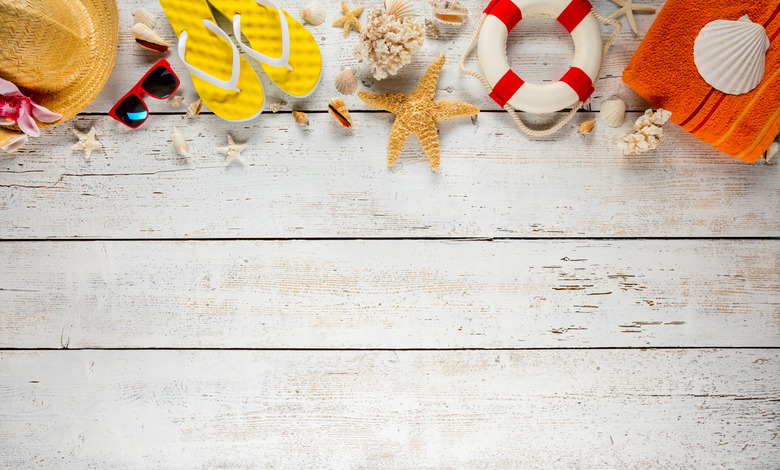How To Whitewash Stained Wood
We may receive a commission on purchases made from links.
Whitewashing stained wood softens and lightens the base color of the furniture, creating a unique, country style finish instead of the classic sheer white of painted bare wood. It's a very DIY way to give a home a more relaxed and approachable aesthetic and it's not too complicated to get started and have the cottage themed home of your dreams.
Things to Know
Things to Know
Before you do start, remove the clear protective topcoat, so the whitewash adheres. This has no effect on the stain, but it ensures your end-finish is durable and even. Use one of two ways to whitewash wood: Apply a liming wax or diluted latex paint. No matter which method you choose, the resulting color will be a softer, lighter version of the original stain.
Work in a well-ventilated area and wear gloves throughout the entire process, from stripping to applying the protective finish. Put on a face mask if you're sensitive to fumes, and dress in old clothes; chemicals, liming wax and paint will ruin your favorite jeans or shirt.
Prepping the Furniture
Prepping the Furniture
Start sanding the furniture with 220-grit sandpaper to remove any residue left behind by the stripper and smooth out the finish. Don't attempt to make the wood feel perfectly smooth – a slightly uneven texture complements whitewash. Once that's done wipe everything down with a tack cloth or damp towel. If you plan to use liming wax, first brush the wood with a bronze brush to open up the pores, so the wax can penetrate the surface. Always sand and brush with the grain, not against it.
Most wood species respond well to liming wax or diluted paint for whitewashing, so you can choose any kind, but some require special care. Pine, cedar, redwood and fir, even when stained, tend to absorb liming wax and diluted paint unevenly. After sanding and prior to whitewashing, apply a wood conditioner according to the manufacturer's directions. Another issue is seeping sap and residue, common with outdoor furniture made from cypress. Wipe the furniture down with mineral spirits just before whitewashing.
Whitewashing: Wax or Paint
Whitewashing: Wax or Paint
In the past, whitewashing was done with lime, chalk and water; liming, a mix of just lime and water, was also used. But because lime is caustic, take advantage of modern, safer options: Liming wax or diluted latex paint.
Liming Wax
Liming Wax
This modern alternative to a classic whitewashing solution gives an authentic look and feel, and it works best for furniture such as dressers, buffet tables and bookcases. Although the results provide a solid, stunning finish, waxes aren't ideal for well-used tables and chairs or anything used outdoors.
To apply the wax, fold a piece of cheesecloth or a lint-free cloth over several times. Scoop some liming wax onto the cloth and work it into the furniture using circular motions and as usual, go with the grain of the wood. Your goal is to work the wax deep into the wood, not just apply it to the surface. The wax blends easily, so you don't have to worry about delineation between areas.
Post Waxing
Post Waxing
Remove any excess wax with ultra-fine steel wool, buffing with the grain of the wood. Don't use a lot of pressure – just skim the surface until the finish looks as even as possible.
Wait the amount of time recommended by the liming wax manufacturer and then apply plain paste wax as a protective topcoat. Paint on at least two coats and be sure to buff off excess between coats with ultra-fine steel wool.
Be gentle with the furniture in the month after it's wax. Make sure to keep heavy, hot or wet objects off of it for at least 30 days so the wax can cure and stay on the wood.
Diluted Paint or Primer
Diluted Paint or Primer
This relatively easy whitewashing technique is perfect for furniture that is used pretty often. If you're finishing outdoor furniture, use exterior, water-based paint and polyurethane. Dilute white latex paint with equal parts water in a plastic container, stirring well to combine. Opt for distilled water if possible.
Brush the whitewashing solution on the furniture using long, even strokes, starting with just one horizontal or vertical surface; i.e., the face of one drawer or the top of a table. Immediately wipe off the excess paint with a damp sponge. Keep repeating this process, moving from section to section, until everything is covered. Let this dry completely and apply another coat if you'd like more coverage.
Apply two to three coats of matte or satin polyurethane. If you'd like an ultra smooth finish, lightly sand with 320-grit sandpaper between each coat, wiping off the dust before applying the next.
